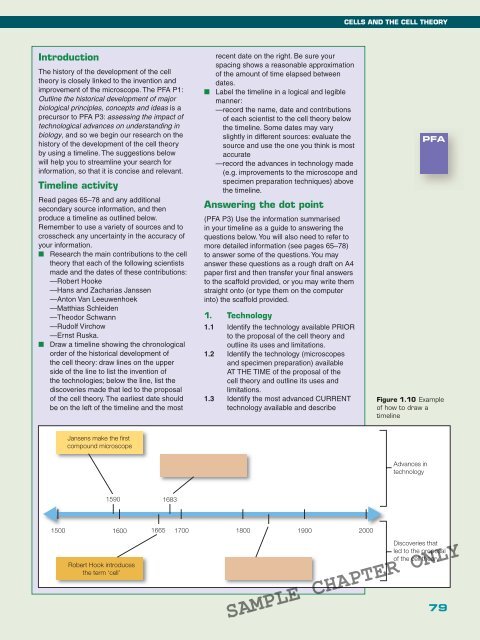BIOLOGY IN FOCUS
BIOLOGY IN FOCUS
BIOLOGY IN FOCUS
You also want an ePaper? Increase the reach of your titles
YUMPU automatically turns print PDFs into web optimized ePapers that Google loves.
CELLS AND THE CELL THEORY<br />
Introduction<br />
The history of the development of the cell<br />
theory is closely linked to the invention and<br />
improvement of the microscope. The PFA P1:<br />
Outline the historical development of major<br />
biological principles, concepts and ideas is a<br />
precursor to PFA P3: assessing the impact of<br />
technological advances on understanding in<br />
biology, and so we begin our research on the<br />
history of the development of the cell theory<br />
by using a timeline. The suggestions below<br />
will help you to streamline your search for<br />
information, so that it is concise and relevant.<br />
Timeline activity<br />
Read pages 65–78 and any additional<br />
secondary source information, and then<br />
produce a timeline as outlined below.<br />
Remember to use a variety of sources and to<br />
crosscheck any uncertainty in the accuracy of<br />
your information.<br />
■ Research the main contributions to the cell<br />
theory that each of the following scientists<br />
made and the dates of these contributions:<br />
—Robert Hooke<br />
—Hans and Zacharias Janssen<br />
—Anton Van Leeuwenhoek<br />
—Matthias Schleiden<br />
—Theodor Schwann<br />
—Rudolf Virchow<br />
—Ernst Ruska.<br />
■ Draw a timeline showing the chronological<br />
order of the historical development of<br />
the cell theory: draw lines on the upper<br />
side of the line to list the invention of<br />
the technologies; below the line, list the<br />
discoveries made that led to the proposal<br />
of the cell theory. The earliest date should<br />
be on the left of the timeline and the most<br />
recent date on the right. Be sure your<br />
spacing shows a reasonable approximation<br />
of the amount of time elapsed between<br />
dates.<br />
■ Label the timeline in a logical and legible<br />
manner:<br />
— record the name, date and contributions<br />
of each scientist to the cell theory below<br />
the timeline. Some dates may vary<br />
slightly in different sources: evaluate the<br />
source and use the one you think is most<br />
accurate<br />
— record the advances in technology made<br />
(e.g. improvements to the microscope and<br />
specimen preparation techniques) above<br />
the timeline.<br />
Answering the dot point<br />
(PFA P3) Use the information summarised<br />
in your timeline as a guide to answering the<br />
questions below. You will also need to refer to<br />
more detailed information (see pages 65–78)<br />
to answer some of the questions. You may<br />
answer these questions as a rough draft on A4<br />
paper fi rst and then transfer your fi nal answers<br />
to the scaffold provided, or you may write them<br />
straight onto (or type them on the computer<br />
into) the scaffold provided.<br />
1. Technology<br />
1.1 Identify the technology available PRIOR<br />
to the proposal of the cell theory and<br />
outline its uses and limitations.<br />
1.2 Identify the technology (microscopes<br />
and specimen preparation) available<br />
AT THE TIME of the proposal of the<br />
cell theory and outline its uses and<br />
limitations.<br />
1.3 Identify the most advanced CURRENT<br />
technology available and describe<br />
PFA<br />
Figure 1.10 Example<br />
of how to draw a<br />
timeline<br />
Jansens make the first<br />
compound microscope<br />
Advances in<br />
technology<br />
1590<br />
1683<br />
1500<br />
Robert Hook introduces<br />
the term ‘cell’<br />
1600 1665<br />
1700 1800 1900 2000<br />
Discoveries that<br />
led to the proposal<br />
of the cell theory<br />
SAMPLE CHAPTER ONLY<br />
79
















